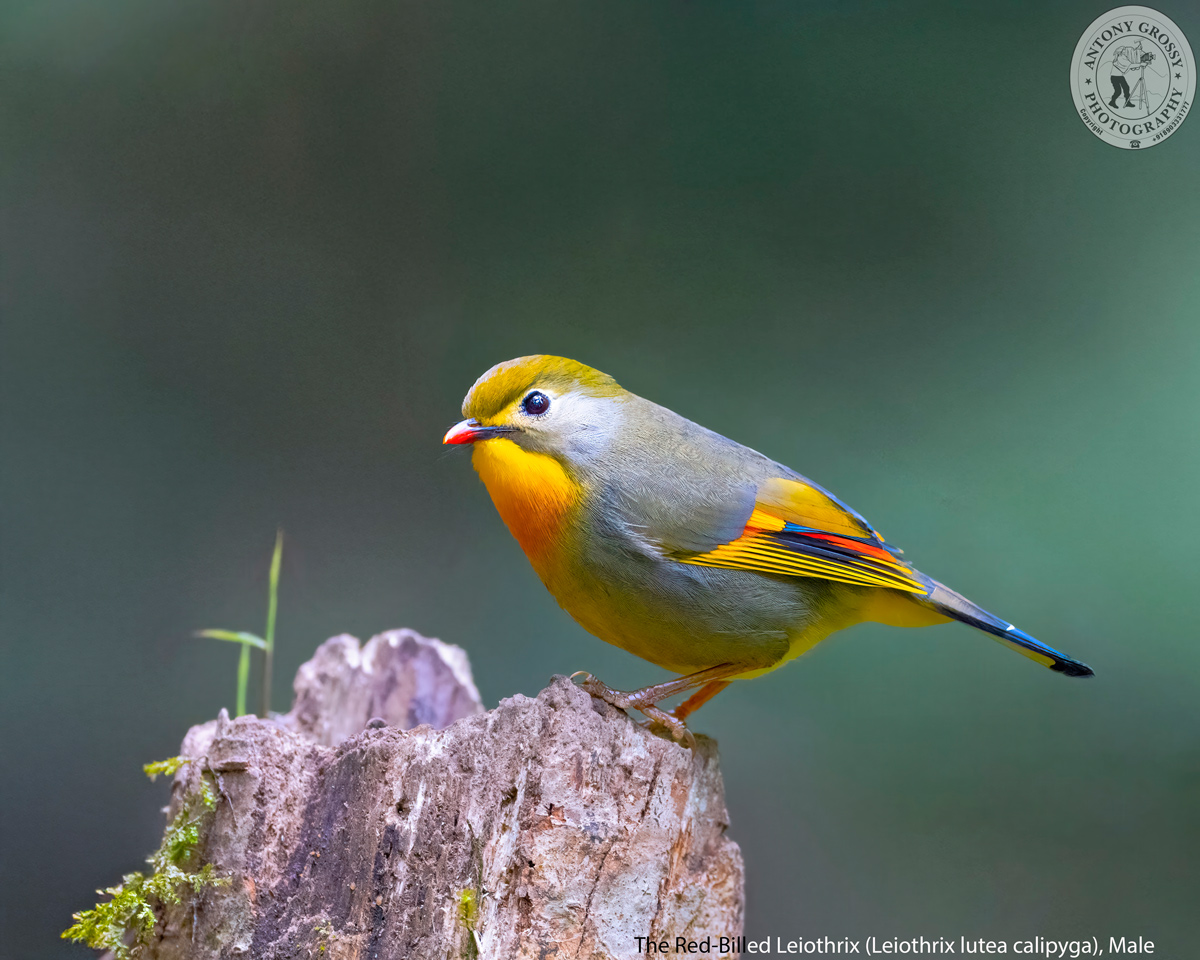

|
 |
| The Vibrant Songbird of the Orient – The Red-Billed Leiothrix, Male |
| The Red-Billed Leiothrix is a plump, brightly
coloured Babbler of dense forest understory. Also known in the cage bird trade as the Japanese Hill-Robin, Peking Robin, or Peking Nightingale. Renowned for their brilliant hues and unique traits, Red-Billed Leiothrix are truly unforgettable. Adults have bright red bills and a dull yellow ring around their eyes. Their backs are dull olive green, and they have a bright yellow-orange throat with a yellow chin; females are somewhat duller than males, and juveniles have black bills. The tail feathers have a peculiar outward curve near the tip. This bird is very active and an excellent singer but very secretive and difficult to see. . . . . . . . . . . . . . . .. .. …. ……. . .. … …… ………………………. ………….. ……………….. .. …. …. ……….. … …. ……….. … …. ………… ………….. ………… ………… ….. ………. …………. …….. ……………. …… …. …. ……….. … …. ……….. .. ………… ….. ………. …………. …….. …………. The Red-Billed Leiothrix is a small, vibrant bird adorned with a conspicuous red bill and a subtle yellow eye-ring. Its plumage is primarily an olive green, while the throat radiates with a bright yellow-orange hue, transitioning to a yellow chin. It is a small olive-grey Babbler reaching a length of only up to 14 to 15 cms in length and weighing 18 to 28 gms, with forked tail, red bill, yellow throat, orange-yellow breast, and red to yellow wing markings. The Male of Nominate race has yellowish-olive crown, shading slowly on nape to mouse-grey upperparts, with very long, whitish-tipped uppertail-coverts. The upperwing has yellow and orange-yellow fringing and large chestnut-red basal patch on primaries, small yellow patch at base of outer secondaries, tail is glossy black; lores and orbital area are yellowish-buff, pale buffish-grey ear-coverts, olive to blackish-olive submoustachial stripe turning grey under ear-coverts and on neck sides. It has strong yellow on chin and throat shading to orange-rufous on upper breast, pale yellow on mid-breast to vent, pale olive-grey flanks. The iris is dark brown to crimson; bill is coral-red with black base. The legs are greenish-yellow to pale brown. The female is slightly smaller than male, with more greenish-olive crown, greyer ear-coverts, duller and smaller reddish wing patch. Juveniles have duller red and yellow wing-patches, yellow throat with rusty breast-band, and slaty-grey upperparts. Cheeks and forehead slaty-grey, with greenish wash; bill black, with varying amounts of red toward tip. There are Five subspecies in that are recognized based on marked differences in colouration particularly on Crown, underside and back. The race Calipyga found in Eastern Nepal East to Bhutan and North East India is similar but yellower above, orange-red fringes of inner primaries extending entire length of feathers. . . . . . . . . . . . . . . .. .. …. ……. . .. … …… ………………………. ………….. ……………….. .. …. …. ……….. … …. ……….. … …. ………… ………….. ………… ………… ….. ………. …………. …….. ……………. …… …. …. ……….. … …. ……….. .. ………… ….. ………. …………. …….. …………. The Red-Billed Leiothrix is usually found in India, Bhutan, Nepal, Burma and parts of Tibet. It has also been introduced to Hawaii, Japan, Reunion Island, and parts of Europe. This species is a bird of the hill forests, found in thick undergrowth in more open broadleaf evergreen, pine and mixed forests, forest edge, secondary growth, scrub including shrub verbena, also abandoned cultivation, tea plantations, bamboo clumps. It is found throughout range at 750 to about 2,300 mtrs. . . . . . . . . . . . . . . .. .. …. ……. . .. … …… ………………………. ………….. ……………….. .. …. …. ……….. … …. ……….. … …. ………… ………….. ………… ………… ….. ………. …………. …….. ……………. …… …. …. ……….. … …. ……….. .. ………… ….. ………. …………. …….. …………. The Red-Billed Leiothrix are omnivores, feeding on grains and seeds feeds on animal matter. It eats fruits such as strawberries, ripened papaya, guavas. Its food is usually gathered from foliage and dead wood and it usually searches for food in lower strata of vegetation. Very active. Usually remains in dense understory vegetation, flitting from plant to plant with short flights and hops between branches. It occasionally ascends trees, gleaning and plucking items, sometimes hanging upside-down, and frequently making short aerial leaps to snatch flying insects. It doesn’t fly frequently, except in open habitats. . . . . . . . . . . . . . . .. .. …. ……. . .. … …… ………………………. ………….. ……………….. .. …. …. ……….. … …. ……….. … …. ………… ………….. ………… ………… ….. ………. …………. …….. ……………. …… …. …. ……….. … …. ……….. .. ………… ….. ………. …………. …….. …………. The song is a somewhat disjointed series of melodious phrases; calls include harsh scolding, chattering, and a repeated peter-peter. … ………… ….. ………. …… ………….. ………… ………… …. … … …… ………….. ………… ………… ….. ………………….. … ………… ….. ………. …… ………….. …………………….. … ………… ….. ………. …… ………….. ………… ………… …. … ……………. …… ……………. ……… ………… …. … ……………. …… ……….. …… ………….. ………… ………… . Description Credit Birds of the World (The Cornell Lab), Oiseaux, Birda, Animalia, Nepal Desk, Ogaclicks, Birds of India | Bird World, Bird Count India & Wiki. |
  |
|
|









































































































































































































































































































































































































































































































































